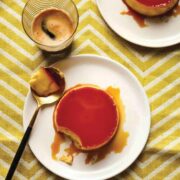
Recipe courtesy of “The Easy Filipino Cookbook: 100 Classics Made Simple” by Roline Casper (Rockridge Press, 2020)
Prep Time: 10 minutes
Cook Time: 1 hour
Serves: 6
Did you know that delicious, creamy caramel is a snap to make? It’s simply just water and sugar. In addition to being a great topping for a wide variety of desserts, it also serves as the primary flavor profile of this family-favorite dessert. Flan originated in Spain but once it made its way to the Philippines, it became an instant crowd-pleaser and a staple at celebrations. Eggs, milk, and sugar make up the creamy custard, and it’s topped with a caramel coating that comes together in minutes — you only need five ingredients!
For the caramel
1 cup sugar and 1/4 cup water
For the leche flan
12 large egg yolks, 1 (14-ounce) can condensed milk, 1 (12-ounce) can evaporated milk, 1 cup sugar
To make the caramel
1. Take out 6 (6-ounce) ramekins.
2. In a heavy-bottomed saucepan, combine the sugar and water over medium heat and let it melt. You can swirl the pan to move it around, but do not stir. Cook for 8 to 10 minutes.
3. While hot, pour the caramel into ramekin molds, making sure the bottoms are covered. Set aside.
To make the leche flan
1. Preheat the oven to 450F.
2. In a bowl, combine the egg yolks, condensed milk, evaporated milk, and sugar.
3. Using a fine-mesh strainer, strain the batter into a bowl.
4. Scoop 1/2 cup of batter into each caramel-lined ramekin and cover each with a square of aluminum foil.
5. Place the ramekins into a baking pan with a high rim and fill water to reach halfway up the side of the ramekins.
6. Bake for 1 hour, or until a toothpick inserted into the center of the flan comes out clean. Take the pan out of the oven. Remove ramekins from the water and let them cool for 5 minutes.
7. With a knife, cut around the edge of each ramekin. Then invert the ramekin onto a dessert plate to release flan. Serve cold or warm.
Variation tip: Try adding 1 tablespoon of calamansi or lime zest to the batter after you strain it in Step 3 for a citrus twist.







